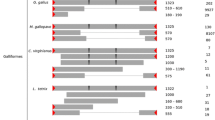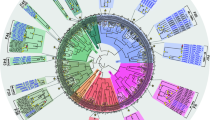Summary
The transposable element mariner occurs widely in themelanogaster species group ofDrosophila. However, in drosophilids outside of themelanogaster species group, sequences showing strong DNA hybridization with mariner are found only in the genusZaprionus. the mariner sequence obtained fromZaprionus tuberculatus is 97% identical with that fromDrosophila mauritiana, a member of themelanogaster species subgroup, whereas a mariner sequence isolated fromDrosophila tsacasi is only 92% identical with that fromD. mauritiana. BecauseD. tsacasi is much more closely related toD. mauritiana than isZaprionus, the presence of mariner inZaprionus may result from horizontal transfer. In order to confirm lack of a close phylogenetic relationship between the genusZaprionus and themelanogaster species group, we compared the alcohol dehydrogenase (Adh) sequences among these species. The results show that the coding region of Adh is only 82% identical betweenZ. tuberculatus andD. mauritiana, as compared with 90% identical betweenD. tsacasi andD. mauritiana. Furthermore, the mariner gene phylogeny obtained by maximum likelihood and maximum parsimony analyses is discordant with the species phylogeny estimated by using the Adh genes. The only inconsistency in the mariner gene phylogeny is in the placement of theZaprionus mariner sequence, which clusters with mariner fromDrosophila teissieri andDrosophila yakuba in themelanogaster species subgroup. These results strongly suggest horizontal transfer.
Similar content being viewed by others
References
Abad PC, Vaury C, Pelisson A, Chaboissier M, Busseau I, Bucheton A (1989) A long interspersed repetitive element—theI factor ofDrosophila teissieri—is able to transpose in differentDrosophila species. Proc Natl Acad Sci USA 86:8887–8891
Ashburner M (1989)Drosophila: a laboratory handbook. Cold Spring Harbor laboratory Press, Cold Spring Harbor NY
Beverley SM, Wilson AC (1984) Molecular evolution inDrosophila and the higher diptera II. Time scale for fly evolution. J Mol Evol 21:1–13
Black DM, Jackson MS, Kidwell MG, Dover GA (1987)KP elements repressP-induced hybrid dysgenesis inD. melanogaster. EMBO J 6:4125–4135
Blackman RK, Gelbart WM (1989) The transposable elementhobo ofDrosophila melanogaster. In: Berg DE, Howe M (eds) Mobile DNA. American Society for Microbiology, Washington DC, pp 523–529
Bodmer M, Ashburner M (1984) Conservation and change in the DNA sequences coding for alcohol dehydrogenase in sibling species ofDrosophila. Nature 309:425–430
Bucheton A (1990)I transposable elements and I-R hybrid dysgenesis inDrosophila. Trends Genet 6:16–21
Capy P, Chakrani F, Lemeunier F, Hartl DL, David JR (1990) Active mariner transposable elements are widespread in natural populations ofDrosophila simulans. Proc R Soc Lond B 242:57–60
Capy P, Maruyama K, David JR, Hartl DL (1991) Insertion sites of the transposable elementmariner are fixed in the genome ofDrosophila sechellia. J Mol Evol 33:450–456
Charlesworth B, Langley CH (1989) The population genetics ofDrosophila transposable elements. Annu Rev Genet 23:251–287
Cohn VH, Moore GP (1988) Organization and evolution of the alcohol dehydrogenase gene inDrosophila. Mol Biol Evol 5:154–166
Daniels SB, Strausbaugh LD, Armstrong RA (1985) Molecular analysis of P element behavior inDrosophila simulans. Mol Gen Genet 200:258–265
Daniels SB, Chovnick A, Kidwell MG (1989) Hybrid dysgenesis inDrosophila simulans lines transformed with autonomous P elements. Genetics 121:281–291
Daniels SB, Chovnick A, Boussy IA (1990a) Distribution ofhobo transposable elements in the genusDrosophila. Mol Biol Evol 7:589–606
Daniels SB, Peterson KR, Strausbaugh LD, Kidwell MG, Chovnick A (1990b) Evidence for horizontal transmission of theP transposable element betweenDrosophila species. Genetics 124:339–355
Engels WR (1989) P elements inDrosophila melanogaster. In: Berg DE, Howe M (eds) Mobile DNA. American Society for Microbiology, Washington DC, pp 437–484
Federoff NV (1989) Maize transposable elements. In: Berg DE, Howe M (eds) Mobile DNA. American Society for Microbiology, Washington DC, pp 375–411
Felsenstein J (1988a) PHYLIP: phylogeny inference package. Version 3.2. Department of Genetics SK-50, University of Washington, Seattle WA
Felsenstein J (1988b) Phylogenies from molecular sequences: inference and reliability. Annu Rev Genet 22:521–565
Finnegan DJ (1989) TheI factor and I-R hybrid dysgenesis inDrosophila melanogaster. In: Berg DE, Howe M (eds) Mobile DNA. American Society for Microbiology, Washington DC, pp 503–517
Fischer JA, Maniatis T (1985) Structure and transcription of theDrosophila mulleri alcohol dehydrogenase genes. Nucleic Acids Res 13:6899–6917
Garza D, Medhora M, Koga A, Hartl DL (1991) Introduction of the transposable elementmariner into the germline ofDrosophila melanogaster. Genetics 128:303–310
Grimaldi DA (1990) A phylogenetic, revised classification of genera in the Drosophilidae (Diptera). Bull Am Mus Nat Hist 197:1–139
Hagemann S, Miller WJ, Pinsker W (1990)P-related sequences inDrosophila bifasciata: a molecular clue to the understanding ofP-element evolution in the genusDrosophila. J Mol Evol 31:478–484
Harris LJ, Baillie DL, Rose AM (1988) Sequence identity between an inverted repeat family of transposable elements inDrosophila andCaenorhabditis. Nucleic Acids Res 16:5993–5998
Helms C, Graham MY, Dutchik JE, Olson MV (1985) A new method for purifying lambda DNA from phage lysates. DNA 4:39–49
Henikoff S, Plasterk HA (1988) Related transposons inC. elegans andD. melanogaster. Nucleic Acids Res 16:6234
Jacobson JW, Medhora MM, Hartl DL (1986) Molecular structure of a somatically unstable transposable element inDrosophila. Proc Natl Acad Sci USA 83:8684–8688
Jeffs P, Ashburner M (1991) Processed pseudogenes inDrosophila. Proc R Soc London B 244:151–159
Kaplan N, Darden T, Langley CH (1985) Evolution and extinction of transposable elements in Mendelian populations. Genetics 109:459–480
Kreitman M (1983) Nucleotide polymorphism at the alcohol dehydrogenase locus ofDrosophila melanogaster. Nature 304:412–417
Kuner JM, Nakanishi M, Ari Z, Drees B, Gustavson E, Theis J, Kauvar L, Kornberg T, O'farrell PH (1985) Molecular cloning ofengrailed, a gene involved in the development of pattern inDrosophila melanogaster. Cell 42:309–316
Lachaise D, Cariou M, David JR, Lemeunier F, Tsacas L, Ashburner M (1988) Historical biogeography of theDrosophila melanogaster species subgroup. Evol Biol 22:159–227
Lemeunier F, David JR, Tsacas L, Ashburner M (1986) Themelanogaster species group. In: Ashburner M, Carson HL (eds) The genetics and biology ofDrosophila. Academic Press, New York, pp 147–256
Lidholm D-A, Gudmundsson GH, Boman HG (1991) A highly repetitive,mariner-like element in the genome ofHyalophora cecropia. Jour Biol Chem 266:11518–11521
Maruyama K, Hartl DL (1991) Evolution of the transposable elementmariner inDrosophila species. Genetics 128:319–329
Maruyama K, Schoor KD, Hartl DL (1991) Identification of nucleotide substitutions necessary for trans-activation ofmariner transposable elements inDrosophila: analysis of naturally occurring elements. Genetics 128:777–784
Medhora M, Maruyama K, Hartl DL (1991) Molecular and functional analysis of themariner mutator elementMos1 inDrosophila. Genetics 128:311–318
Miller DW, Miller LK (1982) A virus mutant with an insertion of a copia-like transposable element. Nature 299:562–564
Misra S, Rio C (1990) Cytotype control ofDrosophila P element transposition: the 66 kd protein is a repressor of transposase activity. Cell 40:269–284
Mizrokhi LJ, Mazo AM (1990) Evidence for horizontal transmission of the mobile elementjockey between distantDrosophila species. Proc Natl Acad Sci USA 87:9216–9220
Nitasaka E, Mukai T, Yamazaki T (1987) Repressor ofP elements inDrosophila melanogaster: cytotype determination by a defectiveP element with only open reading frames 0 through 2. Proc Natl Acad Sci USA 84:7605–7608
O'Brochta DA, Handler AM (1988) Mobility ofP elements in drosophilids and nondrosophilids. Proc Natl Acad Sci USA 85:6052–6056
Rio DC (1990) Molecular mechanisms regulatingDrosophila P element transposition. Annu Rev Genet 24:543–578
Sanger F, Nicklen S, Coulson AR (1977) DNA sequencing with chain-termination inhibitors. Proc Natl Acad Sci USA 74:5463–5467
Scavarda NJ, Hartl DL (1984) Interspecific DNA transformation inDrosophila. Proc Natl Acad Sci USA 81:7515–7519
Scavarda NJ, Hartl DL (1987) Germline abnormalities inDrosophila simulans transfected with the transposableP element. J Genet 66:1–15
Schaeffer SW, Aquadro CF (1987) Nucleotide sequence of theAdh gene region ofDrosophila pseudoobscura: evolutionary change and evidence for an ancient gene duplication. Genetics 117:61–73
Simmons MJ, Bucholz LM (1985) Transposase titration inDrosophila melanogaster: a model of cytotype in the P-M system of hybrid dysgenesis. Proc Natl Acad Sci USA 82:8119–8123
Southern EM (1975) Detection of specific sequences among DNA fragments separated by gel electrophoresis. J Mol Biol 98:503–517
Swofford DL (1989) PAUP: phylogenetic analysis using parsimony, version 3.0. Illinois Natural History Survey, Champaign IL
Templeton AR (1983a) Convergent evolution and nonparametric inferences from restriction data and DNA sequences. In: Weir BS (eds) Statistical analysis of DNA sequence data Marcel Dekker, New York, pp 151–179
Templeton AR (1983b) Phylogenetic inference from restriction endonuclease cleavage site maps with particular reference to the evolution of humans and the apes. Evolution 37:221–244
Throckmorton LH (1975) The phylogeny, ecology, and geography ofDrosophila. In: King RC (eds) Handbook of genetics. Plenum, New York, pp 421–469
Tsacas L, Lachaise D, David JR (1981) Composition and biogeography of the afrotropical drosophilid fauna. In: Ashburner M, Carson HL, Thompson JN Jr (eds) The genetics and biology ofDrosophila. Academic Press, New York, pp 197–259
Ullu E, Tschudi C (1984) Alu sequences are processed 7SL RNA genes. Nature 312:171–172
Xiong Y, Eickbush TH (1988) Similarity of reverse transcriptase-like sequences of viruses, transposable elements, and mitochondrial introns. Mol Biol Evol 5:675–690
Author information
Authors and Affiliations
Rights and permissions
About this article
Cite this article
Maruyama, K., Hartl, D.L. Evidence for interspecific transfer of the transposable element mariner betweenDrosophila andZaprionus . J Mol Evol 33, 514–524 (1991). https://doi.org/10.1007/BF02102804
Received:
Revised:
Issue Date:
DOI: https://doi.org/10.1007/BF02102804




